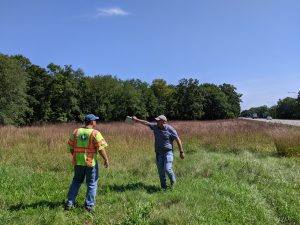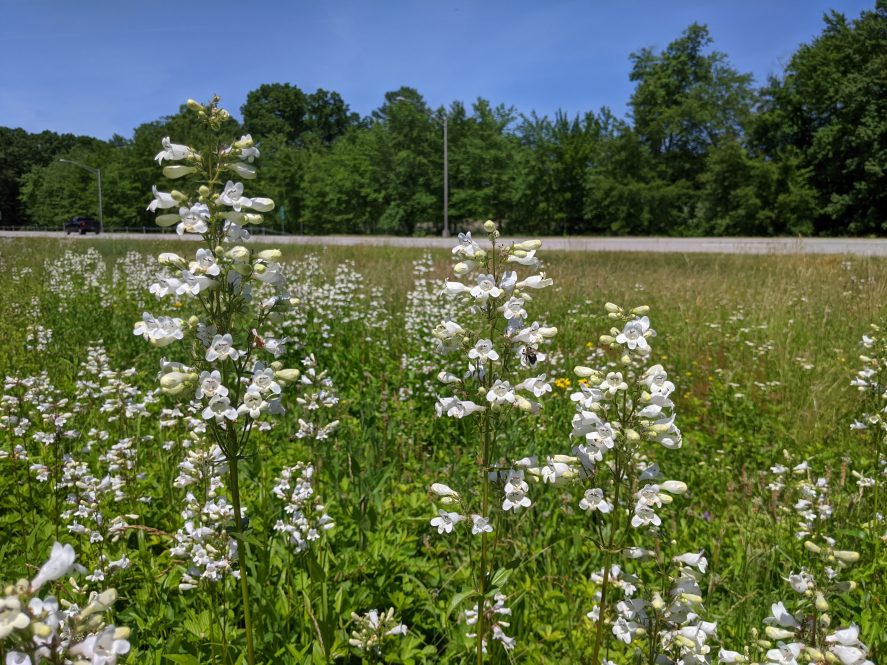The side of Interstate 91 may not be the most obvious site for developing habitat for native plants and pollinators. But roadsides in New England can provide significant ecological benefits when properly managed.
Professor of Horticulture Julia Kuzovkina in the College of Agriculture, Health and Natural Resources has received a grant from the New England Transportation Consortium to make New England’s roadsides more ecologically valuable and sustainably managed by introducing native plants and sustainable management practices to these vital yet overlooked areas.
Because roadsides are long, continuous strips of land, they provide migration pathways for pollinators. Many pollinators have lost these pathways in recent years as human developments fragment landscapes. This means pollinators need to expend extra energy to travel between patches of habitat, making the trip more taxing and dangerous.
“Roadsides constitute a lot of land,” John Campanelli, a graduate student working with Kuzovkina, says. “So their impact, ecologically, is far more than people realize.”
Roadside flora also provides ecosystem services like runoff filtration, carbon sequestration, supporting biodiverse habitats, and improving aesthetics.
The grant will establish demonstration sites in three different New England states. The researchers say they are currently considering areas along Interstate 91 since it corresponds with monarch butterflies’ migration route.
One change Kuzovkina’s team will implement in these test sites is swapping out the “cool-season” turf grasses currently planted along roadsides with more ecologically appropriate “warm-season” grasses.
As their names suggest, cool-season grasses can grow in both warm and cool seasons, while warm-season grasses only grow in warmer seasons, meaning they need to be mowed less frequently.

The need to mow cool-season grasses year-round means the state uses more time, labor, and carbon-emitting machines to maintain them. Warm-season grasses only need to be mowed once a year, reducing all these costs.
Mowing less frequently also allows native plants to thrive and provide wildlife with habitat to nest and lay larvae.
Connecticut implemented reduced mowing practices in 2016, designating Route 6 as a conservation road. Since then, milkweed, the only plant on which monarch butterflies lay their eggs, and other native plant populations along this road have proliferated.
“We can achieve significant benefits by doing just reduced mowing in many areas,” Kuzovkina says. “This is our goal of the project to develop these practices for other states.”
Warm-season grasses also have much deeper roots – three to four feet – compared with cool-season grasses’ six-inch root systems.
Because of their deeper root systems, warm-season grasses are much better at erosion control, which protects the ecosystem and the roads. They are also more drought-resistant because they can reach water deeper underground. This will become increasingly important as global warming makes droughts in New England more common.
In addition to warm-season grasses (which will include little bluestem, purple top, and purple love grasses) the research team will create seed mixes with a variety of native plants that will be short enough to maintain sight lines for drivers and not out-compete each other. The mixes will be designed to include flowers that bloom at different times of year, providing blooms year-round. They will include flowering plants like asters, goldenrod, bee balm, foxglove beardtongue, and milkweed.
All native bees, all native pollinators will benefit from the roadsides. — Julia Kuzovkina
This effort will support all New England pollinators including butterflies and “buzz pollinators” like bumblebees, who use buzzing to vibrate the plant and release its pollen.
“All native bees, all native pollinators will benefit from the roadsides,” Kuzovkina says.
As part of this project, the researchers will help build up New England’s ecotypic seed industry. Ecotypic seeds are native plant seeds grown and used in the same region.
Currently, New England gets its seeds from other parts of the country, like the Midwest, where they have a more robust agricultural infrastructure. Seeds acclimated to the climate in which they were grown may not do well in New England’s environment. This could disrupt the genetic balance between plants and have a negative impact on biodiversity.
With this study, the researchers will connect private seed producers with the stakeholders to encourage the development of the region’s ecotypic seed capacity.
“The seed is harvested from our area, and grown in our area under our climatic conditions,” Campanelli says.
The project will include recommendations for developing public education campaigns to help residents understand that the less-manicured look of the roadsides reflects significant ecological and economic benefits.
“One of the problems that some DOTs encounter, is there’s public resistance because people are so used to the aesthetic of mowed roadsides,” Campanelli says.
While this grant is a two-year study, the researchers say they would like to continue the work since many plants take three to five years to meaningfully establish in a new ecosystem.
“It requires more than two years to see the proliferation of the species and dynamics of this re-installed ecosystem,” Kuzovkina says.



